Tag: building dryer
Commercial dehumidifier TTK 570 ECO scores points with top professional performance features in a budget-friendly design – available again!
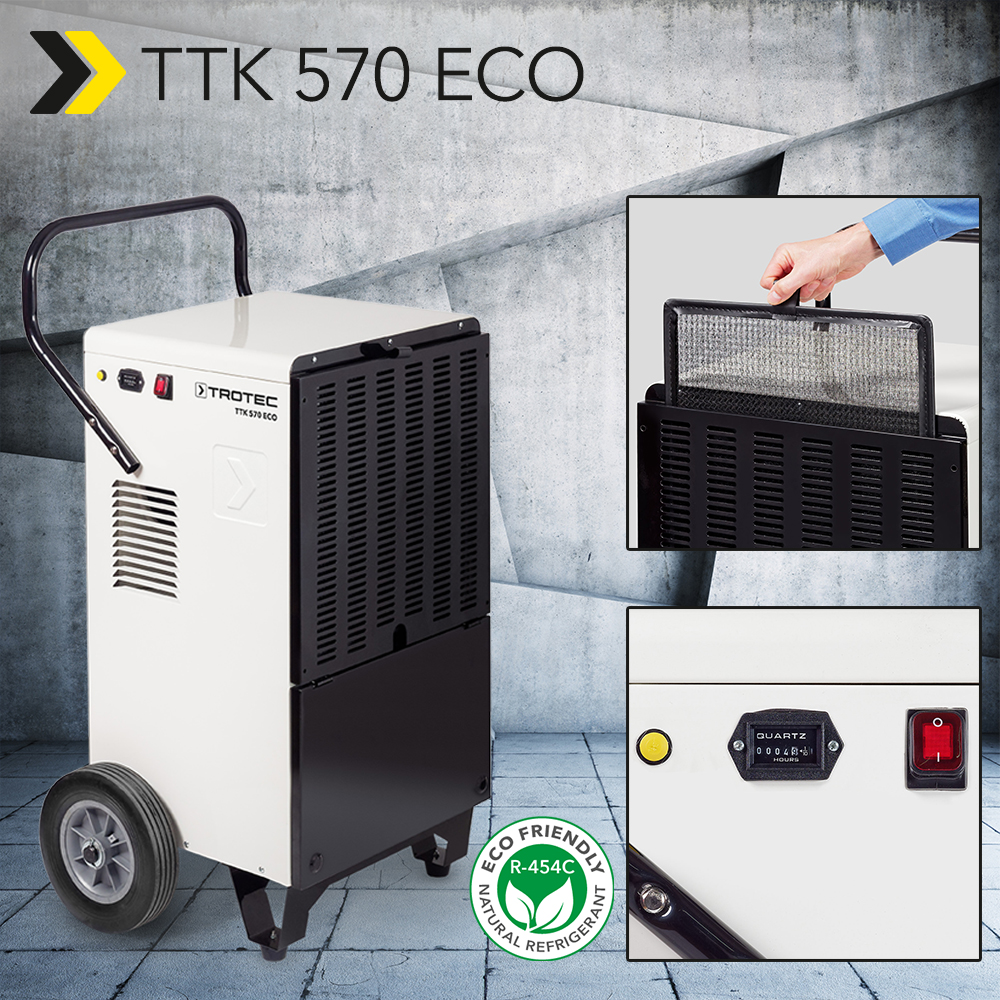 Ultra-robust on the outside thanks to a solid steel construction. On the inside, a powerful rotary piston compressor ensures the high dehumidification performance of 127 litres of water per day. This is the short introduction to our TTK 570 ECO value-for-money champion, which is finally available again – the particularly economical solution for dehumidification applications in the commercial sector. Because the the commercial dehumidifier has a lot more to offer, it’s time we took another look under the professional bonnet …
Ultra-robust on the outside thanks to a solid steel construction. On the inside, a powerful rotary piston compressor ensures the high dehumidification performance of 127 litres of water per day. This is the short introduction to our TTK 570 ECO value-for-money champion, which is finally available again – the particularly economical solution for dehumidification applications in the commercial sector. Because the the commercial dehumidifier has a lot more to offer, it’s time we took another look under the professional bonnet …
Trotec Flood Info: The main facts about drying units
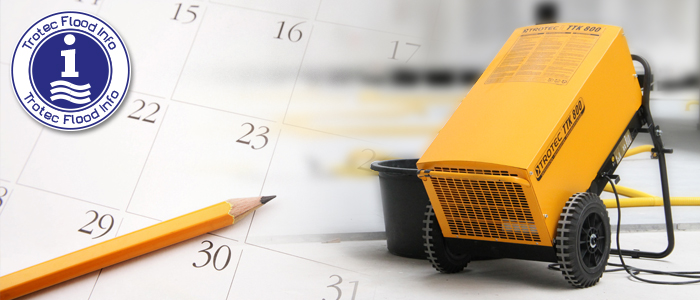
It is very important to make a fast dehumidification because the longer it takes the higher is the possibility that consequential damages appear. How long a dehumidification takes depends on the choice of the drying unit. Another important point is the place where the dehumidifier is set up.
Trotec Flood Damage Services – Help is at Hand When and Where You Need Us
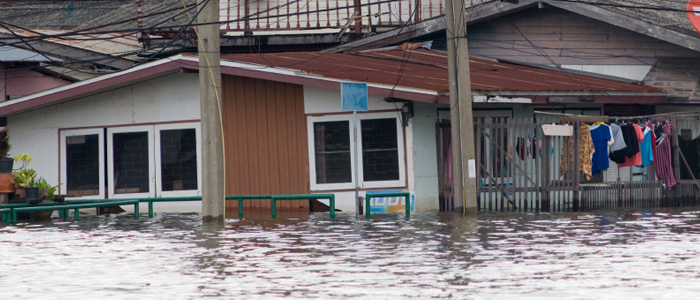
Imagine you’re standing at an upstairs window looking down into your garden, your street or, if you allow your gaze to wander a little further, that part of the neighbourhood you like to call home. Just dwell on the image briefly so as give it enough time to sink in. Now imagine you’re looking out of that same window and the first thing you see is water. Nothing but water. Oh, there are still the street lamps and staunch iron lamp posts standing smartly like soldiers in straight rows along what until just a few moments ago you would have said was your street, and there’s the odd semi-submerged tree and the random traffic sign sticking out almost comically from the floods, but everything – yes, everything – else that you love and have grown used to, everything that is under the height of say your front room ceiling, has gone, simply disappeared under a deep, sweeping mass of sometimes muddy, sometimes swirling, all-engulfing water.
It is an image that strikes a chord of terror and chills your heart. And it is an image that over 2 million people in 20 of Thailand’s 76 provinces, or to put it differently a mind-boggling third of the country, are being confronted with this very minute. Read More
Did somebody say summer?
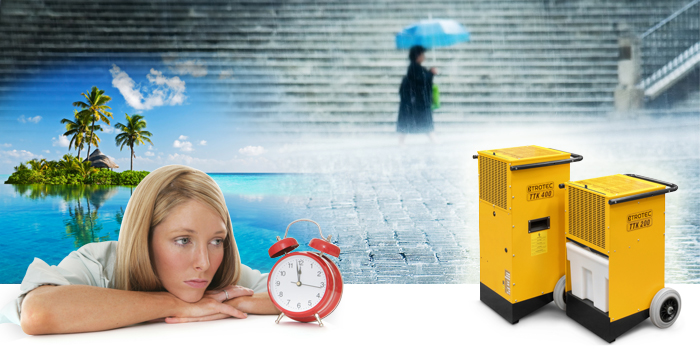
Looking out of the window you wouldn’t believe it was summer. Big, billowy storm clouds the size of battleships hanging ominously overhead, a grey band of rain bringing even more gloom and despondency stretching out on the horizon. You can tune in to whichever radio station or channel you like or go to any website. The weather forecast is always the same: abysmal. Some areas are once again predicted to get a month’s rainfall in only one day. And the next low pressure system is not far behind.
For those of us unfortunate enough to have been affected by these sudden torrential downpours that transform a trickle into a raging torrent and rivulets into rivers, this year will certainly be one to remember. Having previously read or heard about the flooding abroad, in far off places, places where we would not have thought it could have been possible on such a scale it is now our turn to worry whether we are the next, whether it is our town or village that will be hit by the sheer unstoppable masses of water that swell into streets and houses and engulf everything that stands in their way. Read More
TKL to the rescue
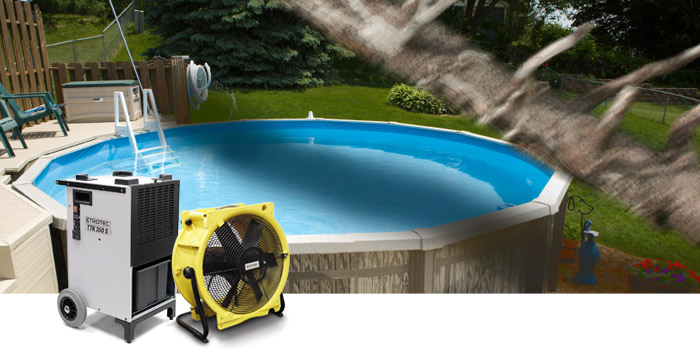 From the diaries of a member of the Trotec media team: How a building dryer and a fan saved my bacon and the day.
From the diaries of a member of the Trotec media team: How a building dryer and a fan saved my bacon and the day.
We all make mistakes. After all to err is human. And if my story helps prevent anyone else from making the same mistake as I did, then some good may come of what nearly turned out to be my own little Waterloo. Read More
Hell and High Water Down Under
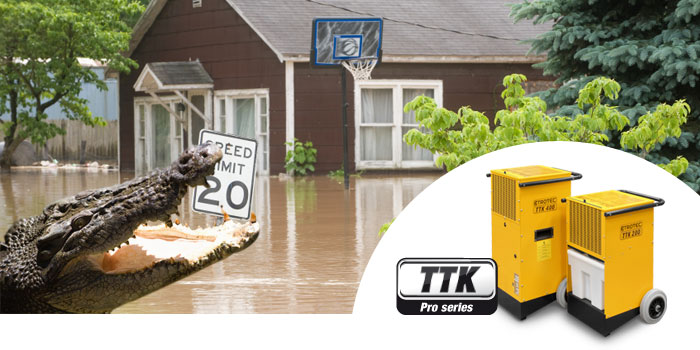
Every year bookmakers up and down the country have a field day with people eager to put their money on the odds of us having a White Christmas. But last year was different. Instead of looking forward to soft, thick snowflakes floating down lazily from the sky most of us were looking forward to one thing only. Less snow.
Last year we were treated to more than our fair share of the heavenly white stuff. But now that the subzero temperatures which turned the snow to ice and the roads to skating rinks have risen the big thaw has started to set in. And as if to make matters worse persistent rain has swollen the rivers and led to unusually high water levels for this time of the year. And that means a high risk of flooding.
We at the Trotec Group have been in the business long enough to know exactly just how bad the consequences of flooding can be. The impact of knowing that your cellar or even the ground floor of your house is submerged or partly under water can hit a man hard and drive him and his family to despair. That’s why we as a company with a professional water damage restoration division are glad that we are able to bring order to the chaos and help out with powerful building dryers and reliable dehumidifiers.
But imagine what it would be like if the situation were even worse?
And in Queensland, Australia it is. What the people of the northeast state are experiencing at the moment is devastating and defies all imagination. Heavy rainfall and high water have led to large-scale flooding, the worst in 50 years, which is currently affecting the lives of over 200,000 people. The area, which is staggeringly the size of both France and Germany put together, has been partly evacuated to save the residents from further calamity and even more dangers. Dangers in the form of a shortage of clean water, flood-related diseases and poisonous water snakes and hungry crocodiles. Already three people have been killed by snakes bites and countless others attacked by marauding reptiles, which like the displaced human population and countless poor animals, are often on the lookout for higher ground where they are, for the time being at least, safe from the floods. As a result the Australian authorities have issued warnings to the marooned victims not to enter the water – which because of the battle that help organizations and rescue services are having reaching them is almost impossible.
Go here to see an interactive map and an image gallery of the flooding in Queensland
Luckily for us the situation in our part of the world is less dramatic. But for those unfortunate souls who are, or soon will be, affected help is at hand. We have the know-how, the experience and the equipment to provide them with everything they need to dry out their buildings and restore their cellars and houses to their previous state. We may not know all that much about Australian wildlife, but we do know a lot about building dryers and water damage restoration.
And Rolf Harris. Tie Me Kangaroo Down, Sport, Tie Me Kangaroo Down…
Prepare yourself and your cellar – the worst is yet to come

The effects of climate change that we experienced in 2010 are cause for grave concern – the images ingrained in our memories of ravaged regions and lost souls still leave us shocked, shaken and helpless. The devastating heat wave in Russia, the horrifying floods in Pakistan or just recently the tsunami in Indonesia– these are probably among the most severe weather catastrophes which happened within the last year.
There are still those who say that these catastrophes cannot be linked to the change in climate and that mankind has had little or nothing to do with global warming and the effect climate change has had, and is having, on our planet. But those who believe that climate change is responsible for the effects we are witnessing by far outnumber the sceptics.
But what can we do? Some changes already seem to be irreversible. And the fruits of what we are succeeding in changing or stopping will only become evident in years, if not decades, to come.
Well, we can start by accepting that there will be many more such situations and catastrophes in the near future and that we quickly need to take some necessary steps and precautions in order to prevent the worst from happening. At this very moment there is a massive project underway in – or to put it more precisely under Mexico City – to build a 62-kilometre long tunnel 150 metres below the city’s surface with just one aim in mind: to protect the 20 million-strong metropolis against flooding and high water.
Mexico City is especially at risk because the mega city is built on a dried out lake and is gradually sinking further and further into the sandy substrate. The city itself is also surrounded by a ridge of high mountains which makes it extremely difficult – and costly – to pump the waste water out of the city and away from its inhabitants.
If nothing is done, and the heavy rainfalls during the wet season continue on such a colossal scale, then the city will literally sink in its own water. And this is what the TEO (Túnel Emisor Oriente) is designed to prevent. The tunnel will conduct the water masses away from the city in a depth of 150 metres to the lower-lying federal capital Hidalgo where they will then be processed by gigantic sewage plants which have been upgraded for exactly this purpose. The tunnel will soon be able to propel 150 m³ water per second to the nether regions, perhaps even as soon as 2012. There is even a German company from Baden-Württemberg involved in this mammoth project, which once again goes to show how highly German technology is regarded all over the globe.
So Mexico City is – for the time being at least – safe, thankfully. But where does that leave the rest of us? Our often antiquated and overburdened drainage systems are unable to cope with the downpours we have been experiencing. And you can hardly rely on sandbags and backflow flaps to stop the floods that ensue when the sewers run over, the dykes give and the rivers burst their banks. Better then to make sure that your washing machines, tumble dryers and any other possessions which you value highly are on a pedestal or other elevated place should the floods swamp your cellar. And if your cellar does one day get submerged in water you can always rely on us to dry it out again.
Prepare for the worst and hope for the best…
Our professional building dryers and dehumidifiers offer a whole range of solutions for dehumidification regardless of the scale. Take advantage of our super special offers which are currently running for new and second-hand dehumidifiers – and make sure you’re well prepared for the wet season!
TROTEC – we won’t leave you standing in the rain!
Damage caused by water is daunting enough
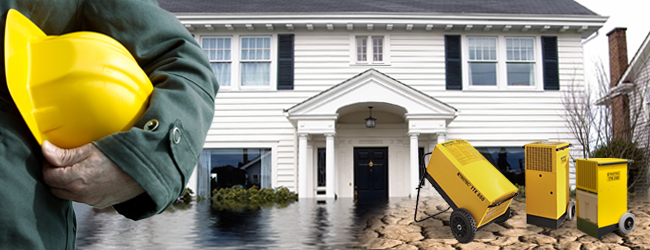
Damage caused by water is daunting enough – get all the help you can with the TTK building dryers from Trotec
It looked as though we were in for a super summer.
Temperatures soared and topped marks on the thermometer which we were only accustomed to being treated to on holiday, in places as magnificent and exotic as the Côte d’Azur, the Italian Riviera, or the Balearic Isles. 35 – 38 – even 40 degrees Celsius – were not uncommon!
The met office confirmed what we already knew: that we were in the grip of a heat wave and that this June was going to be one of the warmest on record.
Ice-cream, air conditioner – and beer – sales exploded. People stayed up late and sat outside pubs and cafes risking turning up at work bleary-eyed the next morning just to savour the Mediterranean feeling and make the most of the unusually beautiful weather.
And then the rain came.
Within weeks the picture was a totally different one. Now it was the rain that was splashed across the front pages and making the headlines. The people who had groaned collectively when they lay awake during the long, hot nights which robbed them of their sleep now had to decide which was worse – too much sun or too much rain.
For those who lived near certain rivers or in certain parts of the country there could only have been one answer. As river levels started to rise and dykes burst and freak flash floods swamped the regions which they lived in, the inhabitants of many German states, especially those which had already been hit by similar catastrophes in previous years, would have given everything to be able to decide.
As many people who have themselves been affected, or who have helped others when these have been hit by floods and high water, the scale of damage that the receding water levels leave behind is crippling, daunting and often heart-breaking. The frustration at perhaps having to start all over again is enough to drive the strongest of men to despair. Luckily for some the damage can be contained – either because the dams or sandbags held and the water was only able to seep into the cellars and lower-lying areas or other precautions were taken and furniture and valuables were moved to higher floors before the floods came.
And because the damage resulting from the masses of water could be significantly reduced and restored by using the right drying equipment.
Building dryers from Trotec are just one of many effective means designed to dry out homes and buildings after water damage. The professional building dryers in the TTK series are extremely robust and reliable units which have proved their worth in tens of thousands of scenarios throughout the country and across the whole of Europe. The range covers a selection of models each designed to deal with damage on a certain scale. The smallest model in the series, the TTK 200, for example, is a high-powered, highly-mobile unit that is excellently suited for drying out rooms up to 250 m³. The brilliant yellow building dryer is equipped with a powerful rotary compressor, an automatic hot gas defrosting system and large, non-marking wheels that allow you to manoeuvre the unit to wherever you want it.
Although the other models like the highly-versatile TTK 400, the TTK 800 powerhouse or the colossal TTK 1500 each have an operating range or an area of application for which they are best suited, they all have a number of things in common: high-quality components, excellent dehumidification values and drying results and a variety of useful functions and valuable features which have earned them the reputation of being the premium choice for small, medium and large-scale drying operations.
Trust in Trotec – the name in building dryers and machines and equipment for water damage restoration.
Problems with moisture for home builders in summer?

Problems with moisture for home builders in summer?
You must be joking!
We’re not, actually. And as anybody who has had the misfortune of having to deal with damage caused by dampness and excess moisture after their house had not been given enough time to dry out will tell you – mould is not a laughing matter.
It is still popular belief among many home builders that summertime is the best time of the year to carry out their building projects because it is warmer – and because it is warmer walls and screed will therefore dry more quickly. Wrong. What they fail to realize is that it is not the temperature which is the deciding factor when it comes to drying out new buildings – it is the relative humidity. And in summertime the relative humidity is still surprisingly high.
Measurements carried out by the met office in Friedberg show that the average relative humidity in June alone was 56% (!) compared to an average relative humidity of 68% throughout 2010.
But help is at hand! Building dryers are used throughout the building trade to dry buildings at all times of the year and not just in the winter months which is what most people would expect. Which building dryer you need depends on the size of your building, the prevailing temperature and, of course, the relative humidity. The best and perhaps most reliable way to determine the size of the building is to use a laser distance meter. Laser distance meters from Leica, for example, can measure room sizes accurately down to four hundredths of an inch (1mm). There’s German precision again for you.
The next step is to determine the temperature and the relative humidity. A tthermohygrometer is practically two devices rolled into one. It can measure the temperature in either degrees Centigrade or Fahrenheit and it provides you with accurate information on relative humidity. It’s a bit like killing two birds with one – er – thermohygrometer.
The third and final step is to enter the information you have gathered into our totally-free-of-charge, no-strings-attached calculator which then determines the dehumidification performance you need before telling you which building dryer will transform your building from a wet one into a dry one.
Oh, yes. And by the way… a single building dryer is all you need to dry out any number of rooms in a building if you follow the steps mentioned above. These steps ensure that you pick the right-sized building dryer for your own individual application. One mustn’t forget, however, that this is only possible if the air can be circulated between the rooms sufficiently. A fan is often the most efficient means of making sure that this is guaranteed.
A combination comprising the right building dryer and the right fan can cut drying times in buildings not only in half but by as much as 75%! This means that you can move into your new home on time and save £’s on heating costs, which can soar up to 200% of what you would normally have to pay simply because dry walls keep out the cold better than wet ones.
You can rest assured that you and your family are moving into a dry house with a healthy indoor climate and that you are saving money in the long run, because there is no need to call in the builders to remove the damage caused by mould and moisture. Not a bad deal really when you come to think of it.

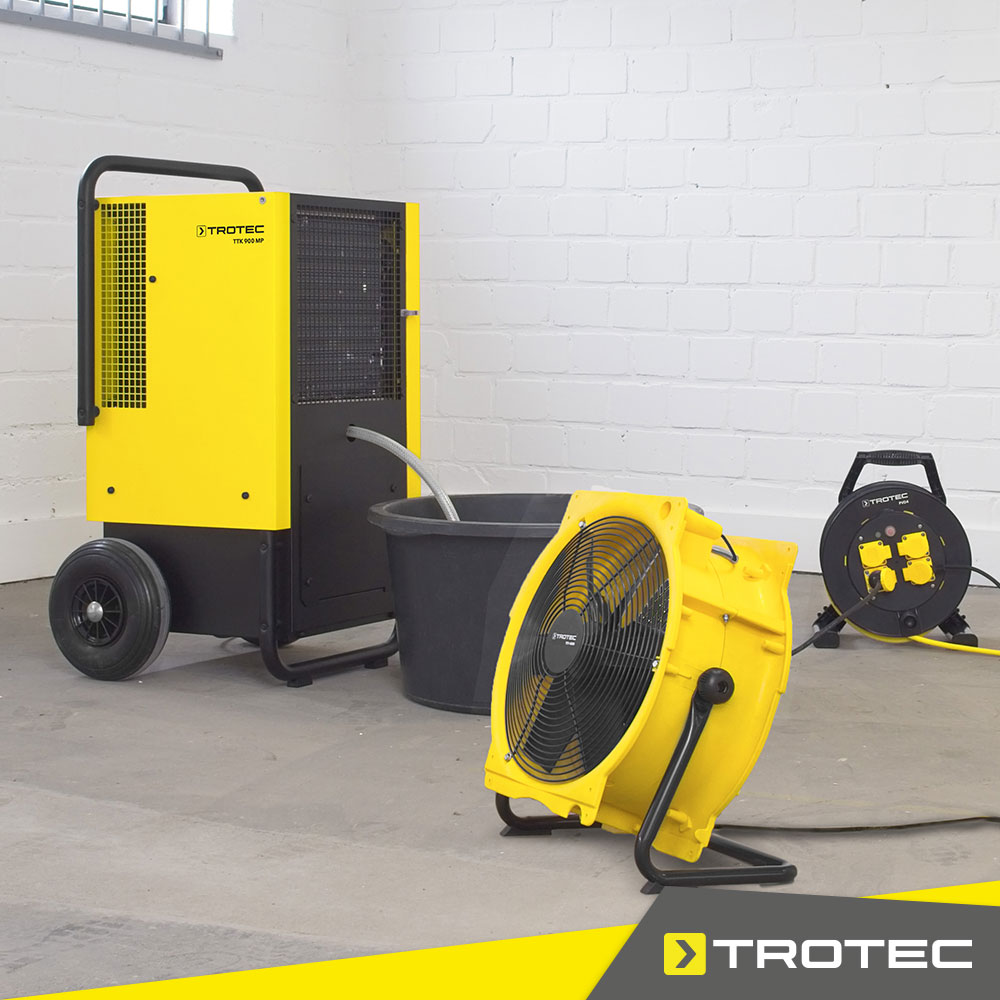 Do you ever get that sinking feeling that the damp patch on your wall isn’t going away? Whether you’re dealing with lingering moisture from water damage or battling dampness in a new-build property, drying walls quickly is paramount in averting mould growth and ensuring efficient construction. While
Do you ever get that sinking feeling that the damp patch on your wall isn’t going away? Whether you’re dealing with lingering moisture from water damage or battling dampness in a new-build property, drying walls quickly is paramount in averting mould growth and ensuring efficient construction. While 
